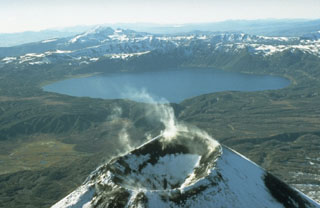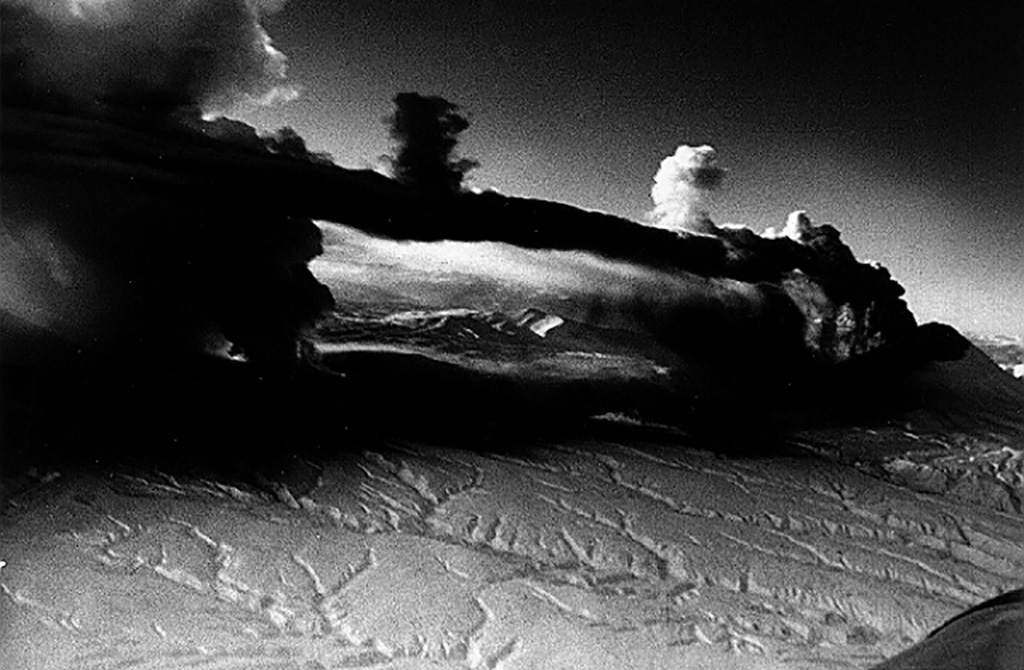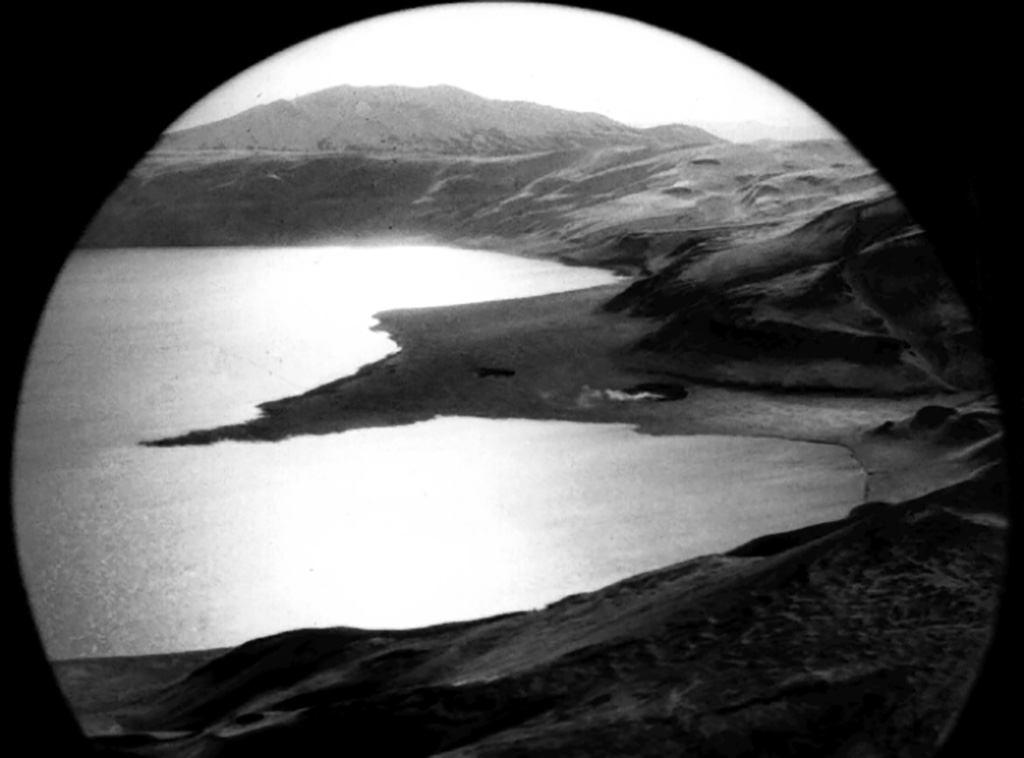Report on Akademia Nauk (Russia) — May 1996
Bulletin of the Global Volcanism Network, vol. 21, no. 5 (May 1996)
Managing Editor: Richard Wunderman.
Akademia Nauk (Russia) Eruptions continue through April; more details of early January activity
Please cite this report as:
Global Volcanism Program, 1996. Report on Akademia Nauk (Russia) (Wunderman, R., ed.). Bulletin of the Global Volcanism Network, 21:5. Smithsonian Institution. https://doi.org/10.5479/si.GVP.BGVN199605-300125
Akademia Nauk
Russia
53.98°N, 159.45°E; summit elev. 1180 m
All times are local (unless otherwise noted)
Eruptions began on 2 January from the summit of Karymsky and from the lake (Karymsky Lake) within the Akademia Nauk caldera (figure 1), previously considered to be extinct (BGVN 21:01-21:03). Eruptive activity at [Karymsky] continued through the end of April.
 |
Figure 1. Schematic map showing some features of the SW part of the Karymsky Volcanic Center. Karymsky Lake lies within the Akademia Nauk Caldera. Courtesy of the Institute of Volcanology. |
Precursory seismicity. Large tectonic earthquakes in the Kronotsky Gulf have historically been among the precursors to eruptions from Karymsky and Maly Semiachik volcanoes. At 1926 on 31 December 1995, a M 5.6 earthquake occurred in the Kronotsky Gulf (50-60 km NE) at a depth of ~60 km. Earthquake swarms are common beneath the large (50 x 35 km) Karymsky Volcanic Center, but an unusually large swarm started on the evening of 1 January with hypocenters to depths of 80 km (figure 2). These followed a M 5.2 foreshock, and at 2157 a shallow M 6.9 earthquake took place centered ~25 km S of Karymsky; this was the largest earthquake recorded beneath the Kamchatkan volcanoes during the past 50 years. Scientists from the Institute of Volcanology and the Kamchatkan Experimental-Methodical Seismological Department of Geophysical Survey, Russian Academy of Sciences, flew to the epicentral zone of the continuing earthquake swarm and observed the onset of the eruption.
Early eruptions at Karymsky volcano. On the afternoon of 2 January the eruption began on Karymsky's upper SW flank 50 m below the old summit crater and from the Akademia Nauk caldera lake, ~6 km S (figure 3). Ash and gas clouds from the summit vent fed a plume rising to 1 km above the crater; the ash-flow rate was estimated to be several cubic meters per second. The eruption cloud extended E towards the ocean and ashfall was visible 40-50 km away.
On the evening on 3 January another crater formed on Karymsky; it looked like a 30-m-diameter amphitheater open to the SW. Sub-vertical Vulcanian explosions occurred from this crater to an altitude of 1 km. Over the next few days, explosions sent gas-and-ash emissions 300-1,100 m high almost every minute.
During the first three days of the eruption, ~500-800 x 103 tons of solid materials, including ash, lapilli, cinder, and bombs, were ejected at Karymsky. During the next 2-3.5 months ~3-4 x 103 tons of andesite-dacite tephra (SiO2 61%) and a small amount of bombs were ejected. An area with a radius of 15-20 km was covered by an ash layer several millimeters thick. The layer's thickness increased along the ashfall axis, reaching 20-30 mm at 4-5 km from the source.
Early eruptions at Akademia Nauk caldera lake. Violent subaqueous explosions on 2 January took place several times every hour in the N part of the 5-km-wide Akademia Nauk caldera lake (figure 4). Explosion clouds rose to 8 km altitude, but most of the tephra fell back into the lake. Ash from Karymsky Lake covered Akademia Nauk volcano and its surroundings. The head of the Karymsky River had its valley and adjacent flood-lands inundated by high water and mud flows.
Although the Akademia Nauk caldera lake had been ice-covered during the winter, after the January explosions water temperature reached 25°C, pH decreased from 7.5 to 3.1-3.2, and mineralization increased from 0.1 g/l to 0.9 g/l. Thermal water compositionally similar to those of the Karymsky springs started to discharge at a new shoal in the N part of the lake. According to preliminary estimates, ~0.015 km3 of material was supplied to the lake during the eruption.
After the lake water had cleared, a subaqueous deposit around the main explosion vent (with a diameter of 1 km) was observed. The N part of the deposit, ~1 km2, was exposed at the surface, forming an arched spit with the adjoining peninsula (figure 5). According to preliminary estimates, ~5-10 x 106 m3 of tephra including sand and rounded fragments of various sizes, and many bombs, formed the deposit there. Their composition ranged from basaltic andesite to andesite-dacite. The volume of deposits on the bottom of the lake is much greater.
Activity through April. During the ensuing days in January, the eruption style at Karymsky dropped to 5-6 explosions reaching 500-900 m high every hour. More vigorous single explosions were exceptional. On 13-14 January, a block-lava flow from the flank crater traveled 400 m, was 50-70 m wide, and averaged 6-10 m thick. In late January the interval between explosions started to increase from 30 minutes to 2-3 hours.
In February only several explosions were observed each day (figure 6). In late February the number of explosions increased to 5-6/hour, but their intensity decreased. In March the number of explosions decreased but their intensity increased. In April the number of explosions increased. For example, on 23 April they took place every 5 minutes. Two additional lava flows were emitted from the flank crater in April.
A dense geodetic network developed since 1972 at the Karymsky Volcanic Center has been measured repeatedly. During the past 20 years, a horizontal extension of Akademia Nauk caldera was observed that may have indicated filling of a magma chamber under the volcano. Measurements made in February and March revealed an extension of 232 cm along the 3.5-km base and subsidence of 70 cm near the area of subaqueous explosions in the caldera lake.
 |
Figure 6. Typical Vulcanian and Strombolian activity at Karymsky, January-April 1996. Courtesy of the Institute of Volcanology. |
Karymsky Volcanic Center. Karymsky and Akademia Nauk are part of the 50 x 35 km Karymsky Volcanic Center (sometimes referred to as the Zhupanovsky volcano-tectonic depression). Located in the Eastern Kamchatka volcanic belt, 30 km from the Kronotsky Gulf and Pacific Ocean, this center contains 21 volcanic edifices, six calderas, and two historically active stratovolcanoes, Karymsky and Maly Semiachik.
The 5-km-diameter Karymsky Caldera formed 7,800 years ago and the Karymsky cone has been growing in the center of the caldera for 5,300 years, ejecting andesitic and dacitic materials. Historical reports on Karymsky's eruptions have been available since 1771. During that period of time, more than 20 prolonged eruptions were separated by quiet periods as long as 10 years. The most recent previous eruption continued from 1970 to 1982.
Akademia Nauk caldera, which was named by the famous Russian volcanologist Vladimir Vlodavetz in 1939, is located immediately to the S in the SW part of the Karymsky Volcanic Center. Its activity began about 50,000 years ago. The N part of the caldera is occupied by Karymsky Lake (4 km wide, 12.5 km2 in area, and 80 m deep). The Akademia Nauk chloride-sodium springs, with 1.3 g/l mineralization and temperatures >250°C in the interior part of the hydrothermal system, discharge along the lake's S shore.
Geological Summary. The lake-filled Akademia Nauk caldera is one of three volcanoes constructed within the mid-Pleistocene, 15-km-wide Polovinka caldera. The eroded Beliankin stratovolcano, in the SW part of Polovinka caldera, has been active in postglacial time (Sviatlovsky, 1959). Two nested calderas, 5 x 4 km Odnoboky and 3 x 5 km Akademia Nauk (also known as Karymsky Lake or Academii Nauk), were formed during the late Pleistocene, the latter about 30,000 years ago. Eruptive products varied from initial basaltic andesite lava flows to late-stage rhyodacitic lava domes. Two maars, Akademia Nauk and Karymsky, subsequently formed at the southern and northern margins of the caldera lake, respectively. The northern maar, Karymsky, erupted about 6,500 radiocarbon years ago and formed a small bay. The first recorded eruption from Akademia Nauk took place on 2 January 1996, when a day-long explosive eruption of unusual basaltic and rhyolitic composition occurred from vents beneath the NNW part of the caldera lake near Karymsky maar.
Information Contacts: S.A. Fedotov, V.A. Budhikov, G.A. Karpov, M.A. Maguskin, Ya.D. Muravyev, V.A. Saltykov, and R.A. Shuvalov, Institute of Volcanology, Russian Academy of Sciences, Petropavlovsk-Kamchatsky, 683006, Russia.





